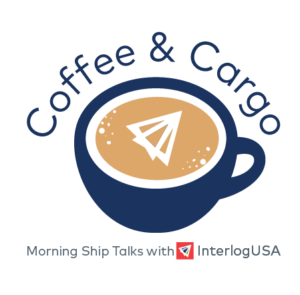Competitive Edge
February 2nd, 2022
Stay Current with Interlog’s Weekly Newsletter:
Sign up for our next Coffee & Cargo webinar –> CLICK HERE
To watch last month’s webinar –-> CLICK HERE
Ocean Freight Market Update
Headlines
- Global container line schedule reliability hit its lowest ever point in December 2021, according to a Sea-Intelligence report
- Los Angeles port handled just 385,251 TEUs of import cargo in December. That’s down 16% year-on-year and down 18% from December 2018, pre-pandemic
- Shipping-related greenhouse gas emissions rose by 4.9% in 2021 and were higher than in 2020 and 2019
UPDATE: Notable U.S./Canada Port Congestion
- New York/Newark: 23 Backlogged Vessels
- Charleston: 27 Backlogged Vessels
- Norfolk/Newport News: 44 Backlogged Vessels
- Los Angeles/Long Beach: 56 Backlogged Vessels
- Note: This does not include LA/LB bound vessels waiting at ports of origin
- Vancouver: 64 Backlogged Vessels
IMPORT: Asia to North America (TPEB)
Recent Developments:
- Congestion and vessel dwell times at U.S. and Canadian WC ports remain critical as cargo piles up
- Charleston port has especially seen a spike in congestion
- Demand on TPEB lanes is expected to remain strong into the next month
Rates: Rate levels remain elevated but are expected to soften post-Chinese New Year. Shippers with urgent cargo or those looking to restore empty inventories are paying premium rates to secure space.
Space: Space remains critical.
Capacity/Equipment: Capacity remains severely under. Equipment deficits critical.
TIPS: Book at least 4 weeks prior to CRD. Strongly consider premium service and carrier IPIs through the PSW gateway. Be flexible as it comes to equipment and routing.
IMPORT: Europe to North America (TAWB)
Recent Developments:
- Schedule reliability is not expected to improve any time soon due to continuing congestion at both European and U.S. ports
- Port congestion remains manageable at most USEC ports
- However, Houston port has seen recent increases in congestion
- USWC ports, notably Long Beach/Los Angeles, remain heavily congested
Rates: Rates levels to remain notably high. Further increases are expected for February.
Space: Space remains critical, especially for the USWC.
Capacity/Equipment: Capacity remains tight for both North Europe and Mediterranean services. Equipment availability at ports, however shortages remain at inland terminals.
TIPS: Book 5 or more weeks prior to CRD. Strongly consider premium service for higher reliability and no-roll guarantees.
EXPORT: North America to Asia
Recent Developments:
- Diminishing schedule integrity is contributing to void sailings, delays, vessel cut-offs at ports, and challenging post earliest return dates
- Vessel arrivals remain fluid for USWC POLs
- For the USEC, Savannah operations have seen improvements, but New York has seen increasing delays
- Rail availability for USWC has become limited with carriers firmly adhering to allocations
Rates: GRI advisories are out for transshipment ports and Oceania destinations for early February.
Capacity: Available capacity remains fluid for USWC POLs. USEC capacity has become for readily available.
Equipment: IPI origins remain adversely affected by deficits on containers and chassis. Standard equipment availability has not been an issue, but special equipment is remains elusive.
TIPS: Book 4 to 6 weeks prior to CRD to secure equipment and vessel space.
AIR FRIEGHT: United States
- Export demand has steadily increased at the end of January with capacity remaining manageable.
- Larger shipments from major outbound gateways can take 2 to 3 days from booking to uplift.
- Most terminals provide reduced free time for storage and have earlier close-outs for exports to meet throughput times and screening requirements.
- Several domestic and international flight cancellations or delays have happened due to Omicron concerns.
- LAX/ORD/JFK terminals have reduced the backlog of inbound cargo rendering a positive effect on the export side.
- Rates to Latin America, Europe, and Asia are all gradually increasing compared to the beginning of January.
- Average dwell time at European hubs is slightly reducing as congestion improves.
TIPS: Book early considering the current dwell time at airports.
Tip Of The Week: How To Avoid Import Delays At Customs
Dealing with importing delays at customs is never fun. We suggest that you have your ISF (Importer Security Filing) documentation prepared in advanced as you can face some stiff penalties if you don’t file in the timeframe. You can learn more here.
Freight News
The Port of Los Angeles and the Port of Shanghai are working together to help reduce emissions and improve air quality
Shipping related greenhouse gas emissions were higher in 2021 than in the last two years, up nearly 5% in 2021, reported Freightwaves. Now, the ports of Los Angeles and Shanghai are working to transition to zero carbon fueled ships by 2030, in collaboration with shipping lines and cargo owners.
This partnership will include focus on phasing out fossil fuel powered vessels, ramping up the introduction of low and zero carbon fuel ships and technologies throughout the decade, improving air quality in and around the port cities of L.A. and Shanghai, as well as decreasing emissions from port operations, Freightwaves reported.
So why Los Angeles and Shanghai? For one, the Port of L.A. has consistently been the busiest container port in the Western Hemisphere for the last 20 years and the Port of Shanghai is the world’s largest port in regards to container output, according to Freightwaves. In addition, the trans-Pacific passage is the busiest container shipping lane in the world, which makes it an ideal lane to focus on, as one of the first green passages.
By the end of 2022, the ports of Shanghai and Los Angeles, as well as the partners involved, expect to have a “Green Shipping Corridor Implementation Plan” finished by the end of 2022, reported the Maritime-Executive. The hope is by 2030, the world’s first zero carbon trans-Pacific containerships will be introduced for shipping lines that qualify.
Global cargo volume grew 6.9% in 2021, as North America had a great year for air cargo
After a struggling November due to congestion at major airports, air cargo volume rebounded and finished with a 6.9% gain for the full year, according to Freightwaves. Previously, in 2020, air cargo demand saw a drop by 10.6% in 2020, but that was mainly caused by the damage in the first half of the year due to the beginning of the pandemic. However, growth opportunities for many airlines were lost due to the pressures of “labor shortages and constraints across the logistics system,” Willie Walsh, Director General said in a statement about the results.
Typical performance in November tends to be the highest all year because of the delivery rush for the holidays. This year, unfortunately, due to the limited airport infrastructure and labor which prevented timely loading of aircraft, were main reasons for the decrease of performance in November.
A few reasons for these air cargo growth numbers include merchandise trade (up 7.7% in November vs. 2019), industrial production (up 4%), significantly low inventory levels, ocean shipping bottlenecks and record high rates, as well as COVID outbreaks which have created an increase in personal protective equipment (PPE), reported Freightwaves.
The outlook for air freight in 2022 looks rather optimistic and similar to 2021, especially with trade growth and the increase in e-commerce. Freightwaves expert, Eric Kulisch, expects demand after Chinese New Year to have a modest decline, but should soar again for the fall peak season.
Sign up for our
industry answers
Our team works to provide valuable, unique, and relevant content to assist you in finding solutions. Sign up now.

